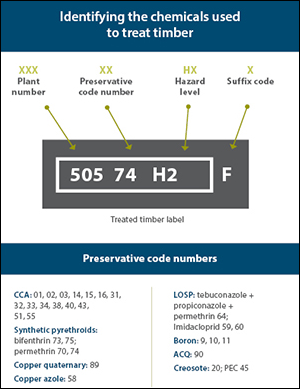
Treated timber label codes
Hazard levels
In Australia, there are 6 main hazard levels with H1 timbers being the least hazardous to human health and the environment. The levels are determined by
- the environment the timber will be placed in: inside, outside, above or in the ground, in fresh water or in seawater
- the types of pests the timber will be exposed to
- its intended use
Hazard levels are defined by
- Australian Standard 1604.1
- chemical type and strength
- penetration depths
- retention rates
See the Hazard level and treatment types chart for more information.
Suffix code
A suffix code on treated timber labels describes the intended use of some timbers within a nominated hazard level. These are
- F for framing
- S for LVL beams
- A for painted LOSP products placed outdoors
Chemical codes
The chemicals and chemical compounds (preservatives) used to treat timbers can be identified by the number in the middle of the label or brand. For example, ‘74’ refers to permethrin.
See the Hazard level and treatment types chart for more information.
Manufacturer number
The first number on treated timber labels refers to the manufacturer of the product. See the Timber Preservers Association of Australia (TPAA) comprehensive list of manufacturers.
Timber treated with copper chrome arsenate (CCA)
CCA treated timber in Australia must be marked with the words ‘Treated with copper chrome arsenate’ either in the form of individual labels fixed to the ends of wood, or as brands along its length.
Some individual items of CCA treated timber do not need to be individually labelled, but the packaging must be marked. These include
- fence palings
- battens
- droppers
- pieces less than 15 mm thick or with a cross section below 1500 mm2

